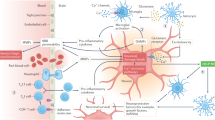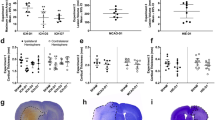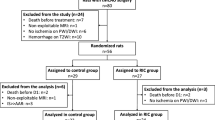Abstract
The penumbra is an area of brain tissue that is damaged but not yet dead after focal ischemia. The existence of a penumbra implies that therapeutic salvage is theoretically possible after stroke. The first decade of penumbral science investigated the ischemic regulation of electrophysiology, cerebral blood flow and metabolism. The second decade advanced our understanding of molecular mechanisms that mediate penumbral cell death. And the third decade saw the rapid development of clinical neuroimaging tools that are now increasingly applied in stroke patients. But how can we look ahead as we move into the fourth decade of penumbra research? This author speculates that a paradigm shift is needed. Most molecular targets for therapy have biphasic roles in stroke pathophysiology. During the acute phase, these targets mediate injury. During the recovery phase, the same mediators contribute to neurovascular remodeling. It is this boundary zone that comprises the new penumbra, and future investigations should dissect where, when and how damaged brain makes the transition from injury into repair.
This is a preview of subscription content, access via your institution
Access options
Subscribe to this journal
Receive 12 print issues and online access
$209.00 per year
only $17.42 per issue
Buy this article
- Purchase on Springer Link
- Instant access to full article PDF
Prices may be subject to local taxes which are calculated during checkout

Similar content being viewed by others

References
Astrup, J., Symon, L., Branston, N.M. & Lassen, N.A. Cortical evoked potential and extracellular K+ and H+ at critical levels of brain ischemia. Stroke 8, 51–57 (1977).
Ginsberg, M.D. Local metabolic responses to cerebral ischemia. Cerebrovasc. Brain Metab. Rev. 2, 58–93 (1990).
Heiss, W.D. Flow thresholds of functional and morphological damage of brain tissue. Stroke 14, 329–331 (1983).
Powers, W.J., Grubb, R.L. Jr & Raichle, M.E. Physiological responses to focal cerebral ischemia in humans. Ann. Neurol. 16, 546–552 (1984).
Lo, E.H., Moskowitz, M.A. & Jacobs, T.P. Exciting, radical, suicidal: how brain cells die after stroke. Stroke 36, 189–192 (2005).
Sharp, F.R., Lu, A., Tang, Y. & Millhorn, D.E. Multiple molecular penumbras after focal cerebral ischemia. J. Cereb. Blood Flow Metab. 20, 1011–1032 (2000).
Baron, J.C. Mapping the ischaemic penumbra with PET: a new approach. Brain 124, 2–4 (2001).
Heiss, W.D. Ischemic penumbra: evidence from functional imaging in man. J. Cereb. Blood Flow Metab. 20, 1276–1293 (2000).
Schlaug, G. et al. The ischemic penumbra: operationally defined by diffusion and perfusion MRI. Neurology 53, 1528–1537 (1999).
Warach, S. Measurement of the ischemic penumbra with MRI: it's about time. Stroke 34, 2533–2534 (2003).
Hoyte, L., Kaur, J. & Buchan, A.M. Lost in translation: taking neuroprotection from animal models to clinical trials. Exp. Neurol. 188, 200–204 (2004).
Lo, E.H. Experimental models, neurovascular mechanisms and translational issues in stroke research. Br. J. Pharmacol. 153, S396–S405 (2008)
Lo, E.H., Dalkara, T. & Moskowitz, M.A. Mechanisms, challenges and opportunities in stroke. Nat. Rev. Neurosci. 4, 399–415 (2003).
Young, D., Lawlor, P.A., Leone, P., Dragunow, M. & During, M.J. Environmental enrichment inhibits spontaneous apoptosis, prevents seizures and is neuroprotective. Nat. Med. 5, 448–453 (1999).
Ikonomidou, C., Stefovska, V. & Turski, L. Neuronal death enhanced by N-methyl-D-aspartate antagonists. Proc. Natl. Acad. Sci. USA 97, 12885–12890 (2000).
Arvidsson, A., Kokaia, Z. & Lindvall, O. N-methyl-D-aspartate receptor-mediated increase of neurogenesis in adult rat dentate gyrus following stroke. Eur. J. Neurosci. 14, 10–18 (2001).
Papadia, S., Stevenson, P., Hardingham, N.R., Bading, H. & Hardingham, G.E. Nuclear Ca2+ and the cAMP response element–binding protein family mediate a late phase of activity-dependent neuroprotection. J. Neurosci. 25, 4279–4287 (2005).
Ikonomidou, C. & Turski, L. Why did NMDA receptor antagonists fail clinical trials for stroke and traumatic brain injury? Lancet Neurol. 1, 383–386 (2002).
Cunningham, L.A., Wetzel, M. & Rosenberg, G.A. Multiple roles for MMPs and TIMPs in cerebral ischemia. Glia 50, 329–339 (2005).
Wang, X. et al. Lipoprotein receptor–mediated induction of matrix metalloproteinase by tissue plasminogen activator. Nat. Med. 9, 1313–1317 (2003).
Wang, X. et al. Mechanisms of hemorrhagic transformation after tissue plasminogen activator reperfusion therapy for ischemic stroke. Stroke 35, 2726–2730 (2004).
Zhao, B.Q. et al. Role of matrix metalloproteinases in delayed cortical responses after stroke. Nat. Med. 12, 441–445 (2006).
Lee, S.R. et al. Involvement of matrix metalloproteinase in neuroblast cell migration from the subventricular zone after stroke. J. Neurosci. 26, 3491–3495 (2006).
Zhao, B.Q., Tejima, E. & Lo, E.H. Neurovascular proteases in brain injury, hemorrhage and remodeling after stroke. Stroke 38, 748–752 (2007).
Gao, Y. et al. Neuroprotection against focal ischemic brain injury by inhibition of c-Jun N-terminal kinase and attenuation of the mitochondrial apoptosis-signaling pathway. J. Cereb. Blood Flow Metab. 25, 694–712 (2005).
Borsello, T. et al. A peptide inhibitor of c-Jun N-terminal kinase protects against excitotoxicity and cerebral ischemia. Nat. Med. 9, 1180–1186 (2003).
Waetzig, V., Zhao, Y. & Herdegen, T. The bright side of JNKs—multitalented mediators in neuronal sprouting, brain development and nerve fiber regeneration. Prog. Neurobiol. 80, 84–97 (2006).
Lees, K.R. et al. NXY-059 for acute ischemic stroke. N. Engl. J. Med. 354, 588–600 (2006).
Shuaib, A. et al. NXY-059 for the treatment of acute ischemic stroke. N. Engl. J. Med. 357, 562–571 (2007).
Ginsberg, M.D. Life after cerovive: a personal perspective on ischemic neuroprotection in the post–NXY-059 era. Stroke 38, 1967–1972 (2007).
Savitz, S.I. & Fisher, M. Future of neuroprotection for acute stroke: in the aftermath of the SAINT trials. Ann. Neurol. 61, 396–402 (2007).
Dirnagl, U., Iadecola, C. & Moskowitz, M.A. Pathobiology of ischaemic stroke: an integrated view. Trends Neurosci. 22, 391–397 (1999).
Huang, Z. et al. Effects of cerebral ischemia in mice deficient in neuronal nitric oxide synthase. Science 265, 1883–1885 (1994).
Iadecola, C., Pelligrino, D.A., Moskowitz, M.A. & Lassen, N.A. Nitric oxide synthase inhibition and cerebrovascular regulation. J. Cereb. Blood Flow Metab. 14, 175–192 (1994).
Lo, E.H. et al. Temporal correlation mapping analysis of the hemodynamic penumbra in mutant mice deficient in endothelial nitric oxide synthase gene expression. Stroke 27, 1381–1385 (1996).
Rhee, S.G. Cell signaling. H2O2, a necessary evil for cell signaling. Science 312, 1882–1883 (2006).
Chen, J. et al. Niaspan increases angiogenesis and improves functional recovery after stroke. Ann. Neurol. 62, 49–58 (2007).
Ushio-Fukai, M. Redox signaling in angiogenesis: role of NADPH oxidase. Cardiovasc. Res. 71, 226–235 (2006).
Shin, H.K. et al. Vasoconstrictive neurovascular coupling during focal ischemic depolarizations. J. Cereb. Blood Flow Metab. 26, 1018–1030 (2006).
Bazan, N.G., Marcheselli, V.L. & Cole-Edwards, K. Brain response to injury and neurodegeneration: endogenous neuroprotective signaling. Ann. NY Acad. Sci. 1053, 137–147 (2005).
Dirnagl, U., Simon, R.P. & Hallenbeck, J.M. Ischemic tolerance and endogenous neuroprotection. Trends Neurosci. 26, 248–254 (2003).
Stenzel-Poore, M.P., Stevens, S.L., King, J.S. & Simon, R.P. Preconditioning reprograms the response to ischemic injury and primes the emergence of unique endogenous neuroprotective phenotypes: a speculative synthesis. Stroke 38, 680–685 (2007).
Sun, F., Gobbel, G., Li, W. & Chen, J. Molecular mechanisms of DNA damage and repair in ischemic neuronal injury. in Acute Ischemic Injury and Repair in the Nervous System (ed. Chan, P.H.) 65–87 (Springer, New York, 2007).
Wahlgren, N.G. & Ahmed, N. Neuroprotection in cerebral ischaemia: facts and fancies—the need for new approaches. Cerebrovasc. Dis. 17 Suppl 1, 153–166 (2004).
Furlan, A.J. et al. Dose Escalation of Desmoteplase for Acute Ischemic Stroke (DEDAS): evidence of safety and efficacy 3 to 9 hours after stroke onset. Stroke 37, 1227–1231 (2006).
Hacke, W. et al. The Desmoteplase in Acute Ischemic Stroke Trial (DIAS): a phase II MRI-based 9-hour window acute stroke thrombolysis trial with intravenous desmoteplase. Stroke 36, 66–73 (2005).
Albers, G.W. et al. Magnetic resonance imaging profiles predict clinical response to early reperfusion: the diffusion and perfusion imaging evaluation for understanding stroke evolution (DEFUSE) study. Ann. Neurol. 60, 508–517 (2006).
Kidwell, C.S. et al. Thrombolytic reversal of acute human cerebral ischemic injury shown by diffusion/perfusion magnetic resonance imaging. Ann. Neurol. 47, 462–469 (2000).
Moustafa, R.R. & Baron, J.C. Pathophysiology of ischaemic stroke: insights from imaging, and implications for therapy and drug discovery. Br. J. Pharmacol. 153, S44–S54 (2008).
Chopp, M., Zhang, Z.G. & Jiang, Q. Neurogenesis, angiogenesis, and MRI indices of functional recovery from stroke. Stroke 38, 827–831 (2007).
Acknowledgements
The speculative ideas presented here have come from innumerable stimulating discussions with many colleagues over the past few years, especially in the context of the stroke progress review group organized by the National Institute of Neurological Disorders and Stroke. I apologize to colleagues whose work could not be cited because of space limitations. Supported in part by a Bugher award from the American Heart Association and grants from the US National Institutes of Health.
Author information
Authors and Affiliations
Rights and permissions
About this article
Cite this article
Lo, E. A new penumbra: transitioning from injury into repair after stroke. Nat Med 14, 497–500 (2008). https://doi.org/10.1038/nm1735
Published:
Issue Date:
DOI: https://doi.org/10.1038/nm1735
This article is cited by
-
Set7/9 aggravates ischemic brain injury via enhancing glutamine metabolism in a blocking Sirt5 manner
Cell Death & Differentiation (2024)
-
Wnt signalling pathways as mediators of neuroprotective mechanisms: therapeutic implications in stroke
Molecular Biology Reports (2024)
-
The dual roles of autophagy and the GPCRs-mediating autophagy signaling pathway after cerebral ischemic stroke
Molecular Brain (2022)
-
Vespakinin-M, a natural peptide from Vespa magnifica, promotes functional recovery in stroke mice
Communications Biology (2022)
-
The neurovascular unit and systemic biology in stroke — implications for translation and treatment
Nature Reviews Neurology (2022)


